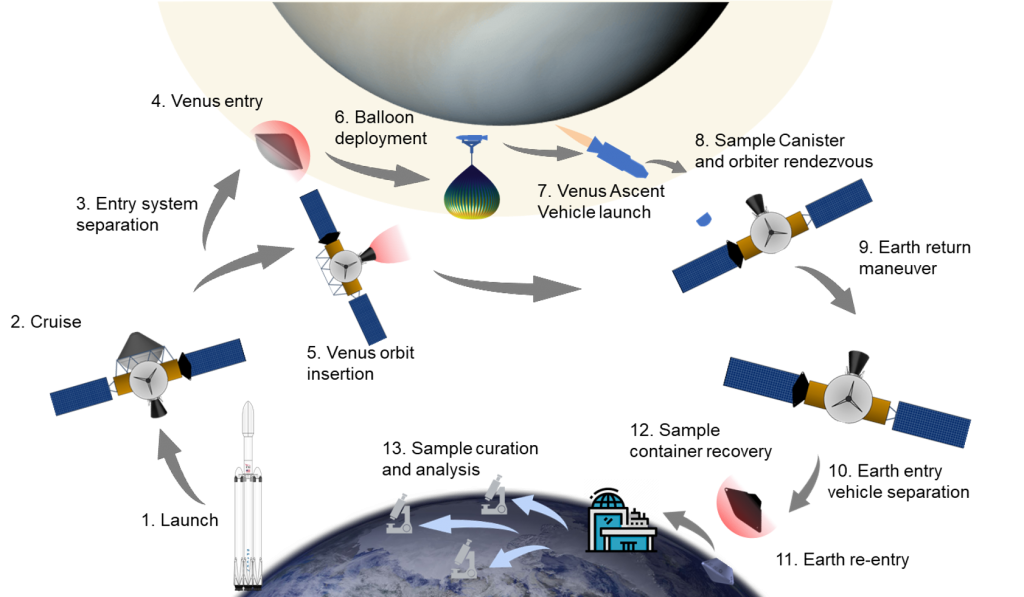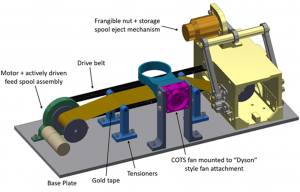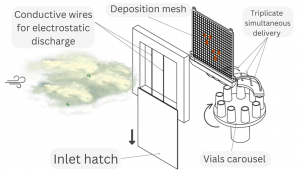The Venus cloud sample return mission will return solid, liquid, and gas samples from the cloud decks of Venus from 48 km to 60 km altitude for detailed analysis on Earth. The mission concept proposes to use a 2-ton rocket to launch up to 500 grams of samples from 60 km to the Venus orbit to rendezvous with an Earth return spacecraft. The rocket is carried through the atmosphere by a single-envelope balloon that can control the ascent rate to meet the sample collection requirements.
Why Sample Return?
A sample return of Venus’s atmosphere and cloud particles is vital for a definitive search for signs of life and life itself. With a sample in hand, scientists can use the most sophisticated instruments on Earth, instruments with a variety and sensitivity not matched by realistically possible spaceflight instruments. On Earth, flexible and adaptive experimental protocols can be followed that are not possible with a remote spacecraft investigation.
Why start now?
A single launch sample return mission is feasible and can be implemented within the next two decades if investments in technology development start now. The existing technologies and those currently under development can be leveraged toward a cloud sample return from Venus. For example, the Mars Ascent Vehicle under development for Mars Sample Return, the commercial sector’s attempts toward balloon-based orbital launch, and aerial platform technology development by NASA for Venus in situ missions, have commonalities with a sample return mission. The preceding Morning Star missions will also act as precursors to the sample return mission by gathering detailed information about the clouds to aid in sample collection and rocket launch and by doing technology demonstrations such as aerial platform deployment. Identifying these synergies between these missions/technologies and the sample return mission now and incorporating them within a technology development roadmap will lead to a realistic mission scenario for returning the cloud sample, enabling rigorous studies on Earth.
NIAC Phase I Study
The team received a NASA Innovative Advanced Concepts (NIAC) Phase I grant in April 2022 to perform a 9-month feasibility study of a cloud sample return mission and some of its key systems, which include solid and liquid sample collectors, Venus Ascent Vehicle, and balloon platform.
Notional Mission Architecture

Solid Sample Collection
 Honeybee Robotics is leading the design and prototyping of a spooled-tape mechanism to collect aerosol particles.
Honeybee Robotics is leading the design and prototyping of a spooled-tape mechanism to collect aerosol particles.
Liquid Sample Collection

Team members at Georgia Tech and MIT are developing a low-mass low-power solution to collect the liquid cloud particles using a “fog harp” mesh design. An innovative method using electrostatic discharge is proposed to increase the collection efficiency significantly.
Balloon Technology

Thin Red Line Aerospace is leading the development of the balloon platform, leveraging on their decades of experience in inflatable solutions and their proprietary Ultra-High Performance Vessel design.
More information …
NIAC Phase I Venus Cloud Sample Return Report
NIAC Symposium 2022 Venus Cloud Sample Return Poster
Venus Life Finder Missions: Sample Collection Strategy, Poster at the Finnish Satellite Workshop 2023
King, I. R., Bywaters, K., Zacny, K., Seager, S., & Petkowski, J. J. (2022). Prototype Design of a Flexible Tape and Roller Sampling System for Venusian Atmosphere Aerosol Capture and Delivery. LPI Contributions, 2688, 8018.
